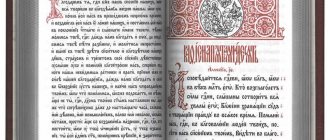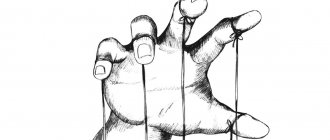Bible Questions and Answers
Published 01/15/2019
Different translations of the Bible say that woman was created from the rib of Adam.
Then the Lord God put the man into a deep sleep and, while he was sleeping, took out one of his rib, and then knitted the man’s skin together in the place from which he took out the rib. The Lord God took a rib taken out from a man, created a woman from it and brought her to the man. The man said: “Finally! She's just like me! Her bone is of my bone, and her flesh of my flesh. She was taken from a man, so I will call her a woman.” (Genesis 2:21-23)
However, the direct meaning of this word in Hebrew is not rib, but “side, side, part.” In addition, the Hebrew root "adm" is used both in the meaning of "man, humanity" and in the meaning of the name "Adam." I have a few questions:
- Why is the word “rib” used in the translation when this is not specified in the original;
- Why is the word "adm" used equally in the sense of "mankind" and "Adam";
- It’s not particularly important to me from which organ a woman was created, but the question of the interchangeability of the words “humanity” and “Adam” matters or is it still not important? For example, adm is a person, aish is a man, ashe is a woman. God created man (adm) in His image; man (adm) named every living creature; there was no suitable helper for Adam (adm); God put man (adm) into deep sleep, etc.
Answer:
The bone that was gone
In the chapter “Creation of the World. Adam and Eve” it says: “...And the Lord God created a woman from a rib taken from a man, and brought her to the man. And the man said, Behold, this is bone of my bones, and flesh of my flesh; she will be called woman, for she was taken from man...” (Old Testament. Bible) If we proceed from the reliability of the divine source, then we should assume that from that time all men on earth should have been born without one rib. Many people who are familiar with biblical literature, but have never touched biology, even believe that this is actually true.
But, normally, both men and women have 12 pairs of ribs and rarely any deviations occur. Moreover, in all adults and healthy people, regardless of gender, 206 bones are involved in the structure of the skeleton. And yet, all anthropologists in the world name one more bone, which about 1.9 million years ago was 207 in a row, but was found only in men. The baculum is a calcium-cartilaginous formation in the connective tissue of the penis, still present in males of many animals, and in particular in most primates. But what does this have to do with it?
Was Eve created from Adam's rib?
Zurara reported that Imam Sadiq, may peace be upon him, was asked about how the generation of the descendants of Adam, may peace be upon him, took place, since people claim that Allah Almighty inspired Adam to marry his daughters to his sons, and that the beginning of all creations among men [thus] come from brothers and sisters.
Related publications
Why is it important to know the time when the Moon is in the sign of Scorpio?
History of the conquest of Mecca
What is the evil eye and how to protect yourself from it?
What is witchcraft and what effects does it have?
Talisman of Imam Rida for reading and carrying in your pocket
His Lordship said: “Glorified is Allah and above all [that people attribute to Him] with great exaltation! Does the one who says this claim that Allah, Holy and Great, has established the foundation of the chosen ones from among His creations, His beloved, the prophets, the messengers, His Proponents, the believing men and women, the submissive men (Muslims) and women, from prohibited (haram) [actions], and that He did not have [enough] power to create them in a permitted [manner]? Although He had already taken from them an agreement on what was permitted, pure, purified and beautiful.
I swear by Allah, I am aware of what [happens in the animal world: when] some animals cover their sisters, and they remain unrecognized to them! [When] they get off them and find out that they [have copulated with] their sisters, they pull out their genitals, grab them with their teeth, and, tearing them off, fall dead!”
Zurara said: “Then the Imam was asked about the creation of Hawa (Eve), and it was told to him that people claim that Allah, Holy and Great, created Hawa from the leftmost rib of Adam.”
The Imam said: “Glorified is Allah and above all [that people attribute to Him] with great exaltation! Does the one who says this claim that Allah, Holy and Great, was not able to create for Adam a wife not from his rib? [After all, as a result, ignorant (low) people began to gossip about this. They claim [that] one part of Adam copulated with another, if it was [created] from his rib... What is [wrong] with them? May Allah judge between us and them!”
Then the Imam said: “Verily, Allah Almighty, after creating Adam from clay and ordering the angels to bow to him, instilled peace (sleep) in him, then created a creation for him - [a woman] and installed her in place the indentations between his thighs. And this was [done] so that women would submit to men. And she began to perform and move, and woke him up with her movement. And when she woke him up, it was suggested to her that she should move away from him. And when he looked at her, at the beautiful creation, [whose] image was similar to his [own], with the only difference that she [was] a woman, he spoke to her, and she [began] speaking to him in his language. He said to her: “Who are you?” She said: “[God’s] creation.” As you see, Allah created me."
Adam said: “O Lord, what is this beautiful creation, the nearness and look of which pleases me?”
Allah said: “O Adam! This is My maidservant - Chava. Do you want her to be with you, keep you company, talk to you and obey your command?“
He said: “Yes, O Lord!” Praise and gratitude to You from me as long as I exist!“
Allah, Holy and Great, said: “Then ask her [hand] from Me, for, verily, she is My servant. She is also suitable for you as a wife for [satisfying] lust."
And Allah put in him [the feeling of] lust, and before that he gave him knowledge of every thing.”
Adam said: “O Lord! Verily, I ask for her [hand] from You! So what [condition] is Your consent to this?“
Allah, Holy and Great, said: “[I give you] My consent [on the condition] that you teach her My religion.”
He said: “This [from me] is for you, O my Lord, if you wish it!”
Allah, holy and great, said: “[I] already wished for this, and already gave her to you [in marriage]. So join her to yourself!“
Adam told her: “Come to me!” But she said: “No, you come to me!” Allah, Holy and Great, ordered Adam to come to her. And if this were not so, women would go to men, asking them [to marry] them.
And this is the story of [the appearance of] Khawa, may Allah bless her.”
Saduq, “Ilal ash-sharay'”, vol. 1, p. 17-18
Key words: Adam Jafar ibn Muhammad Sadiq Khawa
Translation is inaccurate
In 2015, biblical textualist Zaiony Zevit, a professor at the American Jewish University in Bel-Air, California, together with a group of linguists from the founder of the Biblical Archaeological Society in the United States, Herschel Shanks, announced a new reading of this part of the Old Testament chapter.
Scholars argue that the word "rib" in the canonical translations of the Bible does not accurately reflect the Hebrew and Aramaic sources. An error occurred in the texts during translation and census, during which the word meaning stick, bone, was translated as misfortune. While in Hebrew, which did not have the word penis, this very stick-bone was called baculum (animals). Linguists also suggest that the ancient Hebrew word “tsela,” which is usually translated as rib, actually means the foreskin of the penis. At the same time, German scientists specializing in the languages of ancient Sumer also believe that the story of the “rib woman” is an old mistake of translators.
Analyzing the texts of some Sumerian myths in various ancient languages, they came to the conclusion that in the original source the phrase “a woman from a rib who was given life” was translated incorrectly. German historian, anthropologist and linguist, Professor Ragnar Borsheim, argues that the actual reading of this phrase is “a woman for a rib (baculum) giving life.” And although this has to do with pagan Middle Eastern myth, and not with Christian literature, during the writing and subsequent translation of the Old Testament texts, the same words and phrases were used, but their exact meaning was lost.
“We are at the mercy of stereotypes formed by reading fiction”
First of all, it must be said that the “rib” from which the woman was created should be perceived as a complex image that requires the use of different approaches to be explained. It can be assumed that in primordial man both the masculine and feminine principles were equally present. Saint Innocent of Kherson, for example, writes about this: “A rib or bone here is not something simple. It must mean the whole half of the being separated from Adam during sleep. How this happened, Moses does not say and it is a mystery. What is clear is that first a common organism had to be formed, which then divided into two types: husband and wife.”
It is this co-equality, the same essence of woman and man that the Bible is trying to convey to us, using the image of a rib. But why was this particular image used? And how can we understand whether we are interpreting this mysterious plot correctly? To answer these questions, we will have to take a brief excursion into the specifics of the biblical text itself and try to penetrate the thinking of people of distant antiquity, to reconstruct the cultural context within which they lived.
The fact is that the difficulties of reading the Holy Scriptures are largely due to the fact that today we are at the mercy of stereotypes formed by reading fiction. And this - let us note, beautiful - sphere accustoms us to the fact that the author tries to reveal all the images, characters, events to us as broadly and fully as possible. And if the intention of the work implies that we must perceive something allegorically or speculate, we are already prepared for this either by the words of the author or by the genre of the work itself, that is, we are prepared in advance for a certain approach to the perception of the text. No one will interpret the text of the fable literally.
With the Bible, everything is not so clear. Here side by side are historical narratives that imply a literal understanding, the books of Proverbs or Ecclesiastes, written in an instructive genre, and prophetic books in which the historical account is intertwined with mystical fragments interpreted only figuratively.
The book of Genesis, in terms of the narrative about the creation of the world, in this sense breaks all records for the complexity of drawing the line between the historical and allegorical layers of the text. The creation of the world and man is undoubtedly a historical event, and here we are dealing with a reality accessible to perception. But at the same time, there is also an element of mysterious, intelligible reality.
Firstly, this event is not only historical, but also mystical: God creates the world and man with a certain higher purpose, which does not fit into the framework of exclusively material existence. Secondly, “mystery” is associated with the very decoding of images. It is due to the fact that the prophet Moses, who is the author of the book of Genesis, was forced to convey both physical reality and its mystical, invisible side to his audience in the most understandable language for his time. For example, the holy fathers subsequently did the same, expounding for a pagan audience the truths of the Christian faith in the categories of Greek philosophy familiar to them.
Orthodox view on the problem of relationships between men and women
In the famous feature film “Moscow Doesn’t Believe in Tears” there is an episode that marked the beginning of a controversy that smoothly migrated from Soviet kitchens to modern Internet blogs and does not stop to this day. The main character of the film, the magnificent locksmith-intellectual Gosha, sorting out the relationship with the woman he loves, says in an ultimatum form:
– Remember, I will always decide everything myself on the simple basis that I am a man.
For the male part of the population of our country, these words of Gosha immediately became a kind of motto and the last, indisputable argument in family disputes. But for many women they evoke completely different feelings - from bewilderment to indignant rejection.
In fact, why do men consider mere belonging to their own gender a sufficient basis for such statements? Why doesn’t a similar phrase spoken by a woman sound convincing either in a movie or in real life? After all, even in the film, the heroine of Vera Alentova is in no way inferior in personal qualities, and in many ways even surpasses many men, not excluding her beloved Gosha. She managed to raise her daughter alone, graduate from college, and make a career. She is a major leader, a deputy, earns good money, lives in a spacious, comfortable apartment... In general, she has all the attributes of success in life, but her personal life somehow did not work out. And then Gosha, a mechanic who lives in a communal apartment, appears and begins to put her in her place, motivating his right to such behavior only by the fact that he is a man.
A strange picture emerges: a woman can be smarter than a man, have a better education, and earn more than he does, but, despite any, even the highest, achievements, she still has one lot left in the family - subordination to her husband. In this state of affairs, a certain predetermination is visible, from which, if desired, one can conclude that a woman in relation to a man is a deliberately flawed and dependent creature.
You can, of course, refer to the traditional patriarchal structure, which for centuries has shaped such a balance of power, but such an explanation does not make it more fair in the eyes of a woman. The way of life has long since changed; we live in a post-industrial society. And then, no matter how you look at it, we have to admit that it was from there, from patriarchal times, that all sorts of vulgarities came into our language, like the saying “a chicken is not a bird, a woman is not a person.”
But when a modern woman comes to the Church, she is surprised to discover, now in the Christian tradition, the same patriarchal principle of male supremacy. Moreover, the Bible gives this principle an undeniable religious justification in the direct definition of God: ... your desire will be for your husband, and he will rule over you (Gen. 3:16).
And, probably, many women, having read these biblical words, are puzzled by the same question: why did this happen? Why is a woman doomed to a subordinate position? Did the Lord really create her only as a kind of addition to a man, having no independent value, and is a wife lower than her husband in the eyes of God?
Was Comrade Sukhov right?
In European culture, it is traditional to call women the “beautiful half of humanity.” A man, introducing his wife to strangers, says: meet my other half. And the word “sex” itself (in the sense: male-female) clearly indicates its etymological relationship with the word “half”, which has the same root.
But can one half be larger than the other? This question even sounds somewhat strange - after all, half is, by definition, the result of dividing something in half, that is, equally. Therefore, speaking about the origins of the subordinate position of the wife in Christianity, it would be wrong to assume that this subordination is a consequence of the ontological superiority of the husband. Saint John Chrysostom spoke about it this way: “Although the wife is subordinate to us, at the same time she is free and equal to us in honor.”
In the film “White Sun of the Desert,” Comrade Sukhov, having organized the first hostel for liberated women of the East from Abdullah’s harem, wrote a revolutionary slogan on a piece of calico: “Down with prejudices! A woman, she is also a human being.” And although these words look comical, for all their naivety, they are fully consistent with the attitude towards women that exists in the Christian tradition and has its basis in the text of Holy Scripture: This is the genealogy of Adam: when God created man, in the likeness of God he created him, man and He created them a woman, and blessed them, and called their name man on the day of their creation (Gen. 5:1-2).
A woman is equal in honor to a man - primarily because of this common blessing of God received at creation. Therefore, any discussion on the topic of female inferiority and male superiority in the “chicken is not a bird” style can safely be considered unchristian and unbiblical.
There was, however, a curious case in the history of the Church when, at the Macon Council of 585, which gathered the hierarchs of Burgundy, “... one of the bishops stood up and said that a woman cannot be called a man. However, after he received clarification from the bishops, he calmed down. For the Holy Scripture of the Old Testament explains this: at the beginning, where it was about God’s creation of man, it is said: ... he created them male and female, and called their name Adam, which means man made from earth, calling both woman and man that way; thus He called both of them man. But the Lord Jesus Christ is also called the Son of Man because He is the son of the Virgin, that is, of a woman. And He said to Her, when he was preparing to turn water into wine: “What is it for me and for you, Woman?” And so on. By this and many other testimonies this question was finally resolved” (St. Gregory of Tours. History of the Franks).
However, from one historical curiosity it does not at all follow that the Church has ever seriously solved the problem of whether to consider a woman a human being. The sixth century in Western Europe was the century of Christianization of the barbarians. And the remark of one of the participants in the Macon Cathedral was only an echo of the pagan ideas about women among the newly converted Franks and Gauls. So it was not Christianity that gave rise to this ridiculous question. On the contrary, it helped remove it.









